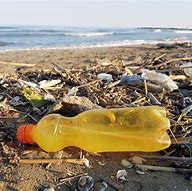WHY ARE MICROPLASTICS BAD? By Pierre Mouchette | Bits-n-Pieces Scientific papers describing small plastic fragments found in birds started to appear in the 1960s, and then plankton net samples in the early 1970s. The science community was fully awakened in the late 1990s to plastics in the environment. Since then, there has been an enormous increase in publications about the many different aspects of plastic, its distribution, its impact on the environment, human and animal health, and well-being.
What are Microplastics? The term "microplastics" was introduced in 2004 by Professor Richard Thompson, a marine biologist at the University of Plymouth in the United Kingdom. For a long time, most people were unaware of the presence of microplastics and their effects on the environment. However, these particles have recently become an important topic of debate after researchers noted their presence in bottled water that was previously considered safe for human consumption. Microplastics are minuscule plastic particles found in the environment. Any plastic particle with a diameter of less than 5 mm (0.19685039 inches) is microplastic, according to the U.S. National Oceanic and Atmospheric Administration (NOAA) and the European Chemicals Agency. Microplastics are classified as either primary or secondary. Primary microplastics are produced and meant for external human use. In contrast, secondary microplastics occur due to the breakdown of large plastic debris. An extensive collection of secondary microplastic exists in the Great Pacific Garbage Patch in the Pacific Ocean. Both primary and secondary microplastics persist in the environment, especially in marine and aquatic ecosystems. What are Macro-plastics? The term “macro-plastics” differentiates microplastics from more significant plastic waste, such as plastic bottles. Two classifications of microplastics are currently recognized.
Sources of Microplastics Some microplastics are manufactured in industries as raw materials for other products. Some occur due to the breakdown of large amounts of plastics, while others are found in tires, textiles, paint ropes, and waste treatment. Aquatic-related studies determine the presence of microplastics in their environment. Studies were done on planktons, muddy and sandy sediments, observing the consumption behavior of vertebrates and invertebrates, and chemical analysis of the pollutants. From these studies, it is evident that there are various sources of microplastics. Wastewater and sewage treatment plants are the primary sources of:
Why Are Microplastics Dangerous? Plastics are indigestible and non-biodegradable that cannot be eliminated once produced. Most of the world’s plastics end up in the garbage, rivers, lakes, and oceans. Large plastics float across oceans and sometimes collect to form garbage patches such as the Great Pacific Garbage Patch. Microplastics, on the other hand, exist on beaches and in deeper waters. Large plastics cause physical damage to marine animals and can result in death. However, the most significant problems are microplastic. They are mistaken for food by marine animals and ingested. They block the digestive system of animals, resulting in low oxygen and reduced energy levels. Some plastics are so tiny that they embed in animal tissues. They are passed across the food chain, and some find their way to humans. Microplastics find their way to humans through ingestion or respiration. Today, the sources of microplastics are so essential to humans that we cannot live without them. Proper plastic handling and thorough wastewater treatment is the best alternative to controlling microplastic.
0 Comments
Your comment will be posted after it is approved.
Leave a Reply. |
Archives
May 2024
|
